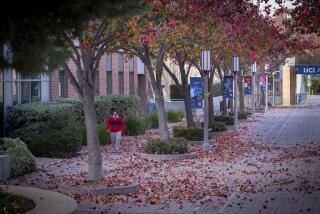UC Chief Rejects ‘Teaching-Only’ Campuses : Education: In taking stock of his first year as system president, Jack Peltason says retreating from research would drive off faculty members and deprive students.
SAN FRANCISCO — Although he acknowledged that some faculty members need to be more visible in the classroom, University of California President Jack W. Peltason on Friday flatly rejected the notion that some campuses in the research-oriented system be converted to “teaching-only” schools.
The issue of how much professors should teach has been a growing topic of debate in the UC system, where full professors generally are required to teach only one or two undergraduate courses a quarter and earn an annual average salary of $75,000. Many are engaged in potentially lucrative research.
Some critics--notably the California Higher Education Policy Center in San Jose--have questioned whether the heavy emphasis on research at the nine UC campuses encourages professors to shortchange undergraduate teaching. As the system’s leaders contemplate construction of a 10th campus in the San Joaquin Valley, officials from the center recently urged that some of UC’s campuses concentrate more on teaching.
“The question we’re really raising is how much research does California need?” said Joni Finney, the center’s associate director.
But Peltason, summing up his first year as president in remarks to the UC Board of Regents, said retreating from UC’s bent toward research would be destructive because it would cheat students and drive top-notch faculty members elsewhere.
“It would simply deprive large numbers of Californians of an education marked by the special liveliness and intellectual excitement that go along with learning from a professor who is engaged in the creation and discovery of knowledge,” Peltason said.
“We already lack the capacity to pay competitive salaries. If, on top of that, we were to discourage some of our faculty from engaging in the work of intellectual discovery . . . (that) would be, in my opinion, ultimately fatal to our efforts to maintain the quality of the university,” he added.
Sen. Lucy Killea (I-San Diego), who attended the regents meeting, disagreed, saying UC needs to work on the attitudes of professors who are too removed from students and who are more interested in the opinion of their research peers.
Peltason acknowledged later that although “most of our faculty are deeply involved in the instructional enterprise, some need to be more involved and we’re taking actions to do that.”
He said the university is examining how to get undergraduates into smaller classes and seminars with research professors, but that the system is too big and diverse to adopt a systemwide teaching requirement.
Meanwhile, university officials told regents that they are encouraged by the growing financial rewards of research, and promised a detailed report in February on how to better capitalize on such “technology transfers” between university laboratories and the marketplace.
V. Wayne Kennedy, senior vice president for business and finance, told regents Friday that UC’s push to market its research has paid off: The university made $44 million in royalty payments from private industry this year, nearly a fivefold increase from 1989.
During the last four years, Kennedy said, the number of university-related patents has increased 50%, the number of preliminary agreements with industry has grown by 2,500%, and UC researchers have uncovered 68% more research that could yield patented discoveries.
Earlier this year, UC officials enthusiastically proposed an ambitious plan for a nonprofit foundation to help spur research, as well as a commercial company that would help fund “gap research,” which is often necessary to propel infant discoveries to practical use. But the plan ran into opposition from some faculty members who complained that UC was becoming more of a business.
Peltason and other university officials acknowledged Friday that the criticism has prompted them to take a second look at the technology transfer program.
More to Read
Sign up for Essential California
The most important California stories and recommendations in your inbox every morning.
You may occasionally receive promotional content from the Los Angeles Times.










